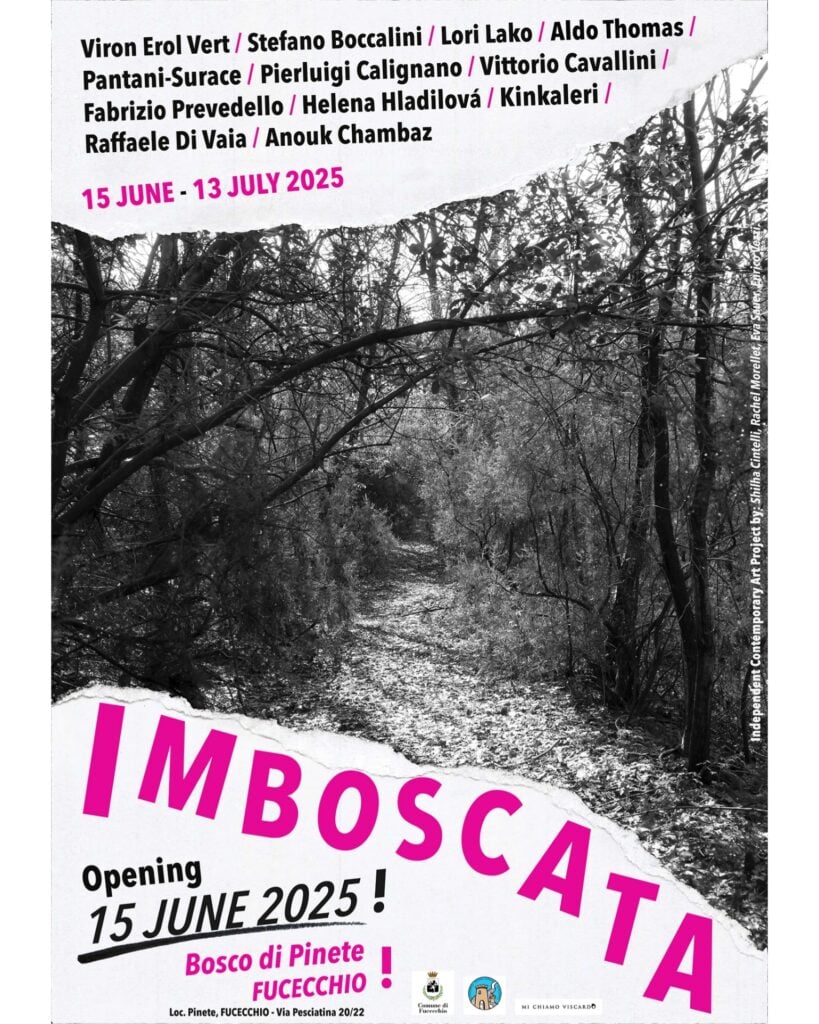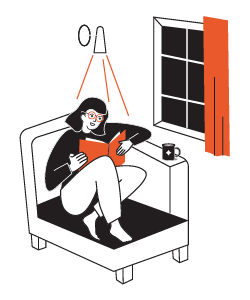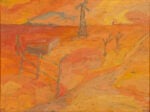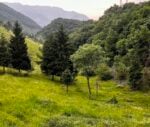Imboscata 2025

Una mostra di arte contemporanea in un bosco con modalità alternative ai canoni espositivi tipici delle mostre di arte ambientale.
Comunicato stampa
𝗜𝗠𝗕𝗢𝗦𝗖𝗔𝗧𝗔 2025 giunge alla terza edizione di un progetto ideato nel 2021 dagli artisti Shilha Cintelli, Rachel Morellet, Eva Sauer ed Enrico Vezzi per coinvolgere altri artisti a misurarsi con la realtà del bosco, sia come eco-sistema che come paradigma.
L’invito rivolto agli artisti partecipanti, è quello di stimolare la produzione di un lavoro specifico, in sintonia con le peculiarità del bosco e concettualmente in linea con la consapevolezza di operare al di fuori dei luoghi urbani dell’Arte. Una mostra di arte contemporanea in un bosco con modalità alternative ai canoni espositivi tipici delle mostre di arte ambientale, con l'obiettivo sia di far vivere un'esperienza diversa al pubblico partecipante e sia di lasciare agli artisti invitati la piena libertà di poter sperimentare. Una mostra pensata per tendere “agguati" allo spettatore, attraverso la collocazione delle opere in situazioni inedite che entrino in dialogo con lo spazio naturalistico. Un progetto espositivo che aspira a promuovere una diversa modalità di fruizione dell’arte contemporanea e dell’ambiente boschivo ed infine a sensibilizzare pubblici di ogni età, ad un corretto rapporto di interscambio tra arte, uomo e natura alla luce di una visione olistica, rispettosa ed ecologica.
In collaborazione con l'Associazione Comitato Francigena Galleno e l'Associazione Mi Chiamo Viscardo, con il patrocinio e sostegno del Comune di Fucecchio e il supporto di Unicoop Firenze Sezione Soci Fucecchio e Regione Toscana Toscanaincontemporanea2025.
𝗜𝗠𝗕𝗢𝗦𝗖𝗔𝗧𝗔
Bosco di Pinete: https://maps.app.goo.gl/GrZsHoP76bqPcW4o7?g_st=aw
Dal 16 giugno al 13 luglio la mostra sarà visitabile liberamente tutti i giorni.
Per le visite dei fine settimana, chiamare o inviare un messaggio ai seguenti numeri:
T. +393498735713 - +39 348 802 9817
Ingresso alla mostra con contributo libero.
——————————ENGLISH VERSION BELOW
APPUNTI PER UN’IMBOSCATA
Il ribelle. L’anarchico. Il singolo che sfugge a ogni controllo capillare, statale, privato, pubblico. É lui, l’uomo che lascia la strada battuta ed entra nel selvaggio cumulo di alberi.
E. Junger
Non è certo una novità andare per boschi. Noi umani nei boschi ci siamo nati. Nei boschi ci siamo evoluti e dai boschi, ad un certo punto, ce ne siamo andati. Eravamo un tutt’uno con i boschi, fino al giorno in cui, uno dei nostri simili, in mezzo ai boschi, si è sentito così a disagio e cosi in pericolo, da decidere di fuggirne. Eravamo in simbiosi con il bosco e le sue spontanee piante curative, fino all’arrivo di noti oscurantismi che hanno manipolato la nostra eredita culturale e il nostro inconscio collettivo. Il bosco non è solo un luogo, ma è il paradigma di una scissione.
Nei secoli, molti filosofi, pensatori, monaci, briganti, esploratori, partigiani ed eremiti, sono tornati nei boschi, sono tornati a vivere e ad abitare nei boschi, per una fuga contraria a quella primigenia. Per fuggire dalla Società o per combattere il potere vigente. Per trovare riparo dalle convenzioni, dalle costrizioni, dai compromessi e dai dettami, che il vivere nella società umana imponeva. In questi ultimi anni invece, molto più che in quelli precedenti al XXI° secolo, ci siamo tutti resi conto che non esiste più quasi nessun luogo sulla Terra dove poter fuggire e ci siamo accorti che la rottura di certi equilibri naturali può generare eventi incontrollabili. Infine, abbiamo preso atto, che in questo nostro pianeta globalizzato, esistono ancora disuguaglianze insopportabili da sostenere nel nostro intimo, anche vivendo nel posto più remoto.
Non è certo una novità andare per boschi, nemmeno per gli artisti. La Storia dell’Arte è piena di esempi e coincidenze di questo tipo. Da chi scappava dagli studi per andare en plein air, a chi andava nei deserti messicani o nello Utah, per protesta e per ritrovare la perduta libertà di operare, fuori dalle logiche di mercato e dentro nuove logiche, che oggi chiameremmo anche eco-logiche.
Non è certo una novità, ma noi vogliamo ancora una volta andare per boschi. Non per fuggire dalla Società degli uomini ma nemmeno per rifugiarsi nelle passeggiate tra gli alberi. Andare e “operare” per boschi e nei boschi, per tenere viva la memoria. Per ricordarci di quello che eravamo e di quello che siamo diventati. Per distinguere nuovamente ciò che è illusione, da ciò che è bagliore di realtà. Concepire e collocare opere nei boschi, per non aver sempre delle pareti in cui ripararci, per non avere pre-concetti come alibi dei nostri limiti e limiti come alibi dei nostri concetti.
Con questo nostro esperimento vogliamo tentare, in modo uguale ma diverso da altri prima di noi, di metterci davanti alla nostra esistenza e interrogarci. Su quali ideologie non vogliamo più abbracciare e su quali ideali desideriamo fondare la nostra convivenza. Quale Antropocene vogliamo alimentare e in quale Natura vogliamo credere. Dentro quali voragini future non vogliamo cadere, per non avere altro destino che quello di estinguersi. L’ Imboscata è una trappola per gli sprovveduti ma una meravigliosa opportunità, per i consapevoli.
Rachel, Enrico, Eva, Shilha
Copyright © 2025 IMBOSCATA, All rights reserved.
English Version:
IMBOSCATA 2025
IMBOSCATA 2025 is the third edition of a project conceived in 2021 by Shilha Cintelli, Rachel Morellet, Eva Sauer and Enrico Vezzi, which aims to invite other contemporary visual artists to confront themselves with a forest, both as eco-system and as a paradigm.
The invitation addressed to the participating artists is to stimulate the production of a specific work, in tune with the peculiarities of the forest and conceptually in line with the awareness of operating outside the urban places of Art. An exhibition of contemporary art in a forest, but an alternative to the typical exhibition canons of environmental art exhibitions: the aim is to make the participating public live a different experience. Also the invited artists have full freedom to experiment. This exhibition is designed to surprise the spectator through the placement of the works in dialogue with the naturalistic space. IMBOSCATA aspires to promote a different way of enjoying contemporary art and the forest environment and finally wants to raise awareness among audiences of all ages, promoting a correct relationship of exchange between art, man and nature in the light of a holistic, respectful and ecological vision.
Our Manifesto:
NOTES FOR IMBOSCATA
The rebel. The anarchist. The individual who escapes capillary control, that of the state, of the private, of a large public. This is the person who leaves the beaten path and enters into the wild of the forest.
E. Junger
It is certainly nothing new to walk into the woods. We humans originally inhabited the wild. Thanks to the woods we evolved and from the woods, at some point, we left. We were one with the woods, until the day when one of our fellows, in the midst of the woods, felt so uncomfortable and so endangered that he decided to flee. We were symbiotic with the forest and its spontaneous healing plants, until the arrival of obscurantisms that manipulated our cultural heritage and our collective unconscious. The forest is not only a place, but is the paradigm of a split.
Over the centuries, many philosophers, thinkers, monks, brigands, explorers, partisans and hermits have returned to the woods, returned to live and dwell in the woods, for an escape contrary to the primal one. To escape from Society or to fight the ruling power. To find shelter from the conventions, constraints, compromises and dictates, which living in human society imposed. In recent years, on the other hand, we have all realized that there is almost nowhere on Earth to escape to, and we have realized that the breakdown of certain natural balances can generate uncontrollable events. We had to gain conscience over the fact that in this globalized planet of ours, there are still unbearable inequalities between people, even living in the remotest place.
It is certainly nothing new to go for woods, even for artists. The History of Art is full of such examples . There are those who escaped from the restrains of a studios to go en plein air, those who went to the deserts of Mexico or Utah, in protest and in search of their lost freedom to work outside the logic of the art-market and within new logics, which today we would also call eco-logic.
Again, all this his is certainly not new, but we once again want to go to the woods. Not to escape from the Society of Men, and not even to take refuge in walks among the trees. The aim is to go and “operate” in the woods, to keep a certain memory alive. To remember what we were and what we have become. To distinguish again what is illusion, from what is a spark of reality. To conceive and place artworks in the woods, so that we do not always have walls in which to protect ourselves, so that we do not have preconceptions as alibis for our limitations and limitations as alibis for our concepts.
With this experiment of ours we want to attempt, in the same way but different from others before us, to question ourselves. On what ideologies we no longer want to embrace and on what ideals we wish to base our coexistence. Which histories of man we want to nurture and what kind of Nature we want to believe in. Into what future chasms we do not want to fall, if we want human kind and mind to thrive. An intellectual imboscata/assault can be a wonderful opportunity for the aware.
Rachel, Enrico, Eva, Shilha.
Copyright © 2025 IMBOSCATA, All rights reserved.



